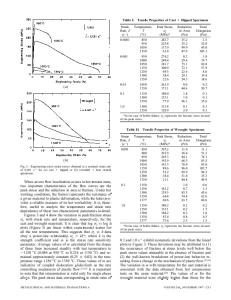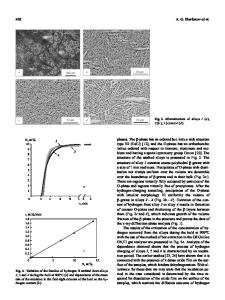Deformation and microstructure development during hot-pack rolling of a near-gamma titanium aluminide alloy
- PDF / 3,287,921 Bytes
- 11 Pages / 613 x 788.28 pts Page_size
- 33 Downloads / 403 Views
I.
INTRODUCTION
CONVENTIONAL hot rolling of sheet materials is a very important industrial process. Tonnage quantities of a wide variety of steels and aluminum alloys are produced for the automotive, appliance, beverage, and other industries by continuous, multistand rolling of large coils. ~ By contrast, sheet products of aerospace materials, such as titanium and nickel-base alloys, are often produced in small lots composed of discrete lengths using single-stand "hand" mills. 12] High labor content and low product yield, among other factors, lead to very high costs for such products, especially for thin gage (~- 200 lOO i 0
t
1 I 1100
I I 1150 1200 TEMPERATURE(~
I 1250
Fig. 5 - Effective stress v s temperature data at various strain rates for Ti-45.5AI-2Cr-2Nb obtained from isothermal hot-compression tests. The stresses are average values for the effective strain interval between 0 and 0.15.
measurements during bare sheet rolling. The good agreement supports the use of a temperature-history independent formulation for the constitutive behavior of Ti-6A1-4V in modeling pack rolling. A similar conclusion was drawn for the modeling of the constitutive behavior of Ti-45.5AI-2Cr-2Nb when the temperature transient takes place solely within a two- or three-phase field. Typical results underlying this conclusion are shown in Figure 4. In this plot, true stress-true strain curves for upset tests conducted at 1095 ~ and a constant strain rate of 1 s 1 are compared. One curve is for a test that involved heating to 1095 ~ soaking, and then compression. The other two curves are
Table III.
Nominal (Furnace) Temperature (~ 1175 1175 1175 1175 1175 1225 1225 1225 1225 1225 1260 1260 1260 1260 1260
Pack Thickness (mm) 18.6 11.4 6.8 5.4 4.2 18.6 11.2 6,7 5.2 4.6 18.5 11.2 6.6 5.2 4.0
for tests in which a higher temperature preheat and soak immediately preceded rapid cooling to 1095 ~ and upset testing. The flow curve of samples given a subtransus preheat of 1260 ~ was essentially identical to that of the conventional isothermal upset test conducted without a temperature transient. By contrast, those tests which included a supertransus preheat at 1320 ~ (in the single-phase alpha field) exhibit a much higher initial stress and large amounts of flow softening that lead to flow stresses at large strains which are comparable to those of the other two test conditions. Microstructure observations (not shown) suggest that the high peak stress and large amount of flow softening seen in samples given the supertransus preheat are a result of (a) the coarse prior alpha grain structure developed during the supertransus exposure and (b) the breakdown of a lamellar structure of large colony size ( - 150 #m), which forms partially during cooldown and partially during upsetting. As has been frequently shown for conventional alpha-beta titanium alloys, t261 the breakdown of lamellar structures with large colonies leads to large amounts of flow softening during hot working. The remaining hot-compression data (from isothermal tests) are s
Data Loading...











